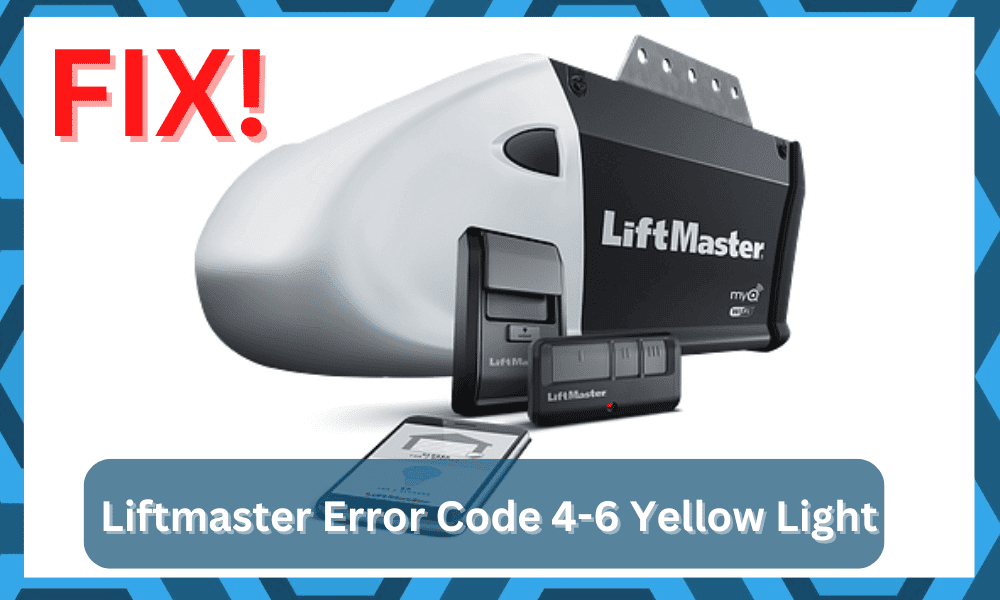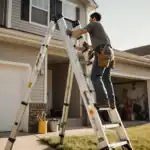Dealing with Liftmaster Error Code 4-6 can be frustrating, especially when it prevents your garage door from closing with the remote. This error code is your opener’s way of telling you one specific thing: it thinks something is blocking the safety sensors.
When this error occurs, you’ll typically see the opener’s light flash 4 times, pause, then flash 6 times. You’ll also notice that the door will not close using the remote, but it will usually close if you press and hold the main button on the wall. This is a safety feature.
In this guide, we’ll walk you through the simple, step-by-step troubleshooting measures to find the obstruction, re-align your sensors, and get your garage door opener back on track.
Key Takeaways: What Error 4-6 Means
- The Problem: The safety sensors (the two “eyes” near the bottom of the door track) detected an obstruction or are misaligned.
- The Symptom: The garage door won’t close with the remote control. The opener light flashes a 4-6 pattern.
- The Solution: You most likely need to clear an obstruction, clean the sensor lenses, or re-align the sensors.
- The Test: Look at the two small LED lights on the sensors themselves. One should be steady amber (sending) and the other steady green (receiving). If the green light is flashing or off, you’ve found the problem.
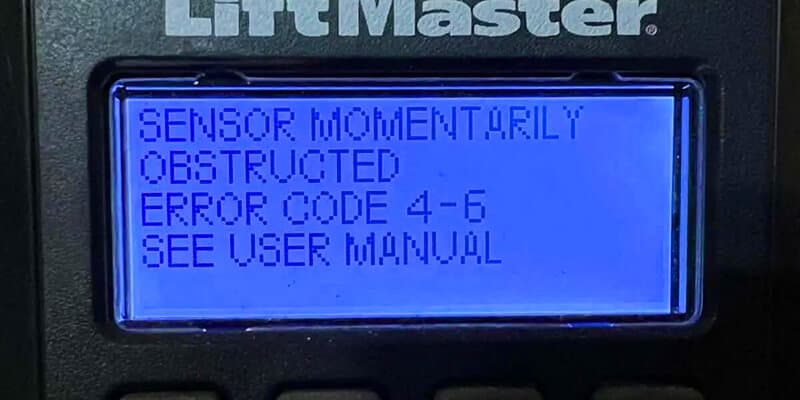
LiftMaster Error Code 4-6 indicates a safety sensor issue, not a problem with the opener itself.
How to Fix Liftmaster Error Code 4-6 (Step-by-Step)
Don’t call a repair person yet. 99% of the time, this is a simple fix you can do yourself in under 10 minutes. Follow these steps in order.
1. Check for Obvious Obstructions
This is Garage Door 101. Go look at the path between the two sensors. Is there a box, a bicycle, a shovel, or a trash can in the way? Even a broom leaning against the wall can block the beam. Move any items out of the path and try the remote again.
2. Clean the Sensor Lenses
The “eyes” get dirty. Cobwebs, dust, or a smudge of grime can be enough to block the invisible infrared beam. Take a soft, clean cloth and gently wipe the lenses of both sensors. If you’ve been doing yard work, a bit of pollen or a stray leaf could be the culprit.
3. Check and Realign the Sensors (The LED Trick)
This is the most common fix. The sensors must be pointed *exactly* at each other. They often get bumped by equipment or even a bouncing basketball.
Here’s how to check:
- Look at the “Sending” Sensor: This one should have a solid Amber LED light. If this light is off or flashing, you may have a power or wiring issue (see Step 4).
- Look at the “Receiving” Sensor: This one should have a solid Green LED light.
- If the Green light is flashing or off: It means it’s not “seeing” the amber sensor. It is misaligned.
To fix it: Gently loosen the wing nut on the flashing green sensor. Nudge the sensor up, down, left, or right *very slightly* while watching the green light. When you get it aligned perfectly, the green light will stop flashing and glow solid. Tighten the wing nut, and your remote should work again.
4. Inspect the Sensor Wiring
If the sensor lights are completely off, or if aligning them does nothing, check the wiring. Wires can get corroded, pulled, or even chewed by pests.
- Visually trace the thin wire from both sensors back to the main opener unit.
- Look for any obvious breaks, pinches, or cuts. Check where the wires are stapled to the wall; sometimes a staple can short the wire.
- Check the connection points on the back of the motor unit. Make sure the small wires are securely in their terminals.
5. Power Cycle the Opener
Ah, the classic “turn it off and on again.” If all the sensors look good, the lights are solid, but it’s still throwing the error, a simple reboot can clear a momentary glitch. Unplug the main garage door opener unit from the ceiling outlet. Wait 60 seconds, then plug it back in. This will reset the logic board and may clear the error.
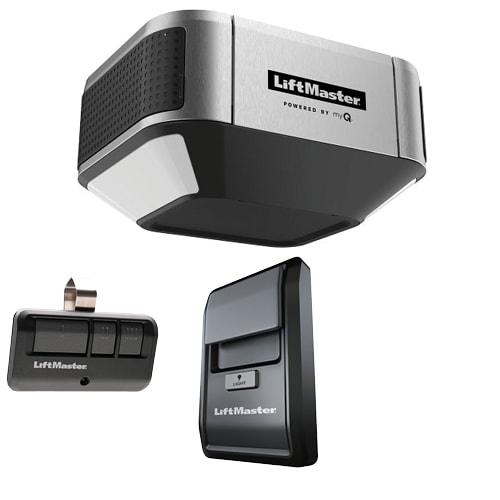
A simple power cycle (unplugging the unit) can sometimes clear a faulty 4-6 error.
LiftMaster Error Codes Diagnostic Chart
If fixing the sensors didn’t solve your problem, or if your opener is flashing a *different* code, your problem may be something else. LiftMaster openers use the UP and DOWN arrows to flash codes to help you pinpoint the exact issue.
Here is a diagnostic chart for common errors.
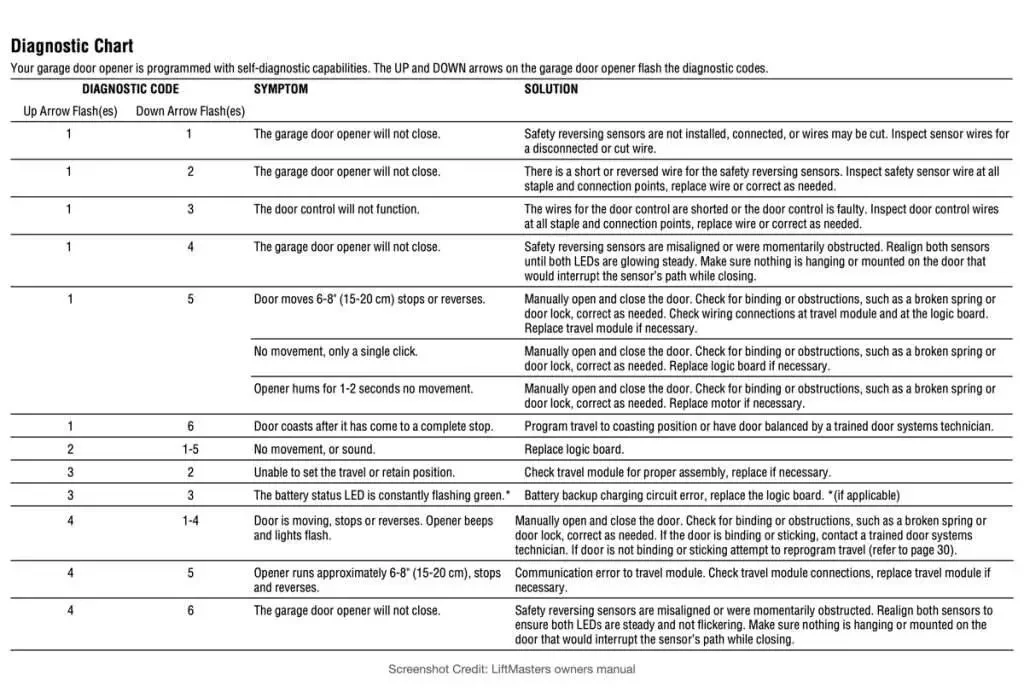
A full diagnostic chart for LiftMaster error codes.
| Error Code | Symptom | Solution |
|---|---|---|
| 1-1 | Door won’t close | Check sensor installation and wiring for damage. |
| 1-2 | Door won’t close, shorted sensor wire | Inspect sensor wiring for shorts, especially due to staples during installation. |
| 1-3 | Door control malfunction | Check wall control wiring for shorts or reversed wires. |
| 1-4 | Door won’t close | Ensure safety sensors are aligned and not obstructed. |
| 1-5 | Door reverses after moving a few inches | Inspect garage door for smooth operation; consider adjusting springs. |
| 1-6 | Door coasts after stopping | Reprogram travel limits or consult a professional for spring adjustment or replacement. |
| 3-2 | Unable to set travel or retain position | Replace the travel module for controlling up and down travel. |
| 3-3 | Battery status LED constantly flashing green | Investigate circuit board issues and consider replacement if necessary. |
| 4-(1-4) | Door stops, reverses, beeps, lights flash | Check for obstructions, broken springs, or accidentally activated locks; call a professional if needed. |
| 4-2 | Excessive opening force detected | Likely indicates a broken spring; inspect and replace if necessary. |
| 4-5 | Opener runs 6-8″ and reverses | Examine travel module connections; replace the module if needed. |
| 4-6 | Sensor momentarily obstructed | Check for sensor blockages, misalignment, or potential wiring issues. |
Frequently Asked Questions (FAQs)
Q: What does Liftmaster error code 4-6 mean?
A: It means the safety sensor beam was obstructed or misaligned. The opener’s logic board detected that the sensors were blocked at some point while trying to close, so it’s disabled the remote for safety.
Q: How do I know if my garage sensors are aligned?
A: Look at the small LED lights on the sensors themselves. The “sending” unit should have a solid amber light. The “receiving” unit should have a solid green light. If the green light is flashing or off, they are misaligned.
Q: Why does my garage door remote not work, but the wall button does?
A: This is the classic symptom of a 4-6 error. It’s a safety feature. The opener lets you close the door by pressing and holding the wall button because it assumes you are standing there and can visually confirm the path is clear. It blocks the remote to prevent you from accidentally closing the door on something (or someone) you can’t see.
Q: Can I fix a 4-6 error code myself?
A: Yes, in almost all cases. This is one of the most common and easiest DIY fixes. Following the steps in this guide (checking for obstructions, cleaning lenses, and realigning sensors) will solve the problem 99% of the time.
Q: What is the difference between Liftmaster error 4-6 and 4-2?
A: This is a key distinction.
- Error 4-6 is a Sensor Problem. The opener *thinks* something is in the way.
- Error 4-2 is a Force Problem. The door was physically hard to open or close. This is often caused by a broken spring, a bent track, or needing to adjust the force settings.
Final Thoughts
Dealing with garage door opener issues can be a hassle, but the LiftMaster diagnostic system makes it much easier. That flashing Liftmaster Error Code 4-6 is almost always a simple sensor issue, not a sign of a broken opener.
By following the simple steps to check for obstructions, clean the lenses, and realign the sensors, you can save yourself the cost of a service call and get your door operating smoothly again. If these steps don’t work, refer to the diagnostic chart or consider checking for other error codes, as the problem may be different.

